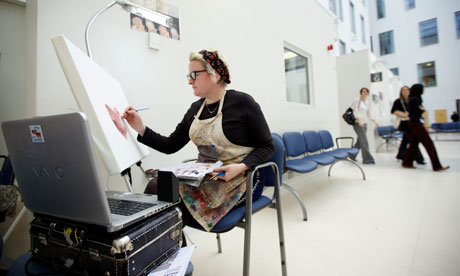Central Manchester University Hospitals NHS trust hosts first museums and galleries week within a hospital setting

- News
- Society
- NHS
Art and minds: hospital trust brings in culture to promote wellbeing
Central Manchester University Hospitals NHS trust hosts first museums and galleries week within a hospital setting
-

- guardian.co.uk, Wednesday 8 February 2012 15.24 GMT
- Article history

Lucy Burscough is at her easel in the atrium of Manchester Royal eye hospital, completing a portrait of the hospital trust's chairman, Peter Mount. She's in the middle of painting the bottom part of his jaw, and one of his ears is still a pencil line. The resemblance is impressive.
Patients waiting for appointments sit nearby, as you'd expect in a hospital, seemingly unflustered by the presence of an artist. Around the corner, a group of people are knitting in a circle by the main hospital entrance. Needles clack with spools of brightly coloured wool as the knitters talk quietly.
Culture Shots is a week-long series of events at Central Manchester University Hospitals NHS trust, aimed at promoting health and wellbeing through exposure to art and culture.
It is the first time in the UK that a trust has hosted a museums and galleries week within a hospital setting. A series of lectures, workshops and performances are taking place in conjunction with institutions including Whitworth art gallery, Manchester art gallery, Manchester Museum and Salford museum and art gallery.
Burscough, the artist in residence at Galaxy House, a residential psychiatric unit for young people, is interested in how society views mental health. "Everybody has preconceptions about mental health and it would be good if we could bust a few myths," she says.
She has a diptych in which one painting has pieces missing and the fragments reappear in the second. "A friend of mine's mother has bipolar disorder and she says when she's on drugs to keep the condition in check, she feels like pieces of her are missing as its part of her personality," she says.
When she works with young people, she says, it is interesting to see how their self-esteem is improved by having their portrait painted. The portraits cannot identify the patients, so instead of faces she focuses on hands or an eye and nose
"I felt they were quite brave having their portraits done," she says. Every one of them were invited to their own private view but none of them felt they could come as they had moved on with their lives when they left hospital. But I hope one day that they'll be able to revisit the portraits." Each has been given their own printed copy of her work.
Burscough adds: "Yesterday I was in an ante-natal clinic and I had a lot of people coming in asking for portraits of their babies. The staff have been interested, too. It's something a bit different."
On Monday, the Manchester Royal Infirmary atrium hosted a live performance based on the story of the suffragette and councillor Hannah Mitchell, which was well-received by staff and visitors.
The eye hospital has a series of brightly coloured glass sculptures on permanent display, with a sign by the entrance imploring people to "please touch" the tactile art. Other sculptures are dotted around the modern building: a metal fish appears from a cabinet, and there's a flutter of butterflies across a wall.
During 70 sessions over the week, the positive contribution to health of spending time in museums and galleries will be promoted.
At St Mary's hospital atrium, in a portable obscure darkroom (Pod), Harriet Hall from Interference Art is encouraging people to empty their pockets or handbags and take photographs of objects, which they develop themselves and take away.

No comments:
Post a Comment